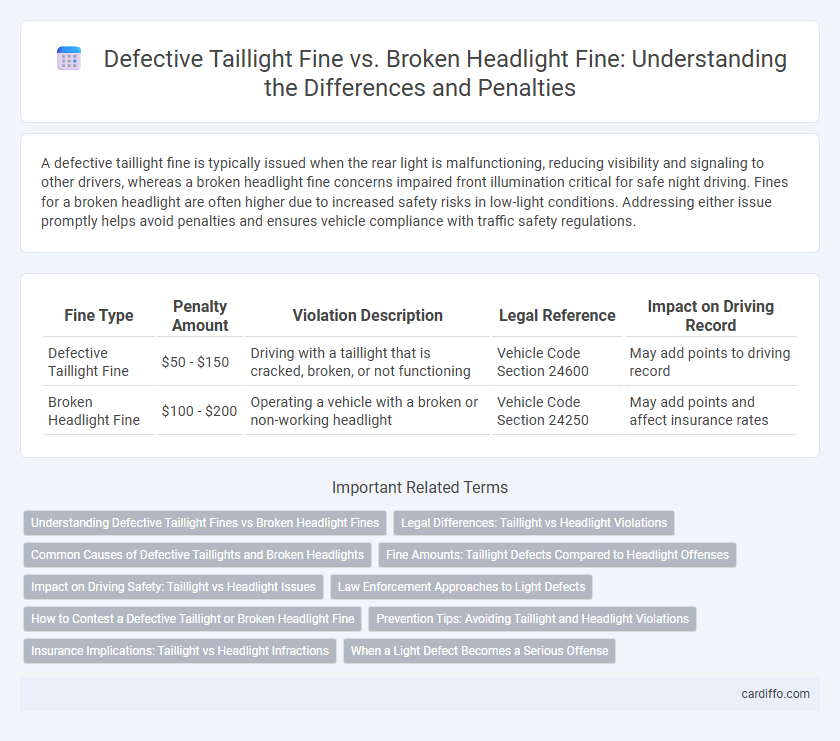A defective taillight fine is typically issued when the rear light is malfunctioning, reducing visibility and signaling to other drivers, whereas a broken headlight fine concerns impaired front illumination critical for safe night driving. Fines for a broken headlight are often higher due to increased safety risks in low-light conditions. Addressing either issue promptly helps avoid penalties and ensures vehicle compliance with traffic safety regulations.
Table of Comparison
| Fine Type | Penalty Amount | Violation Description | Legal Reference | Impact on Driving Record |
|---|---|---|---|---|
| Defective Taillight Fine | $50 - $150 | Driving with a taillight that is cracked, broken, or not functioning | Vehicle Code Section 24600 | May add points to driving record |
| Broken Headlight Fine | $100 - $200 | Operating a vehicle with a broken or non-working headlight | Vehicle Code Section 24250 | May add points and affect insurance rates |
Understanding Defective Taillight Fines vs Broken Headlight Fines
Defective taillight fines typically vary depending on local traffic laws but commonly range from $50 to $150, reflecting the safety risk associated with reduced vehicle visibility. Broken headlight fines are often higher, between $75 and $200, due to the critical role headlights play in nighttime and low-visibility driving conditions. Understanding these fines helps drivers prioritize timely repairs to avoid penalties and maintain optimal road safety compliance.
Legal Differences: Taillight vs Headlight Violations
Legal differences between defective taillight fines and broken headlight fines hinge on visibility regulations and safety concerns; taillight violations typically focus on rear visibility and signaling to other drivers, while headlight violations emphasize forward illumination and nighttime driving safety. Fines for defective taillights may vary by jurisdiction but are generally less severe than broken headlight fines due to the headlight's critical role in preventing accidents in low-light conditions. Enforcement agencies often prioritize headlight compliance during nighttime hours, reflecting the legal emphasis on maintaining adequate road illumination to protect all road users.
Common Causes of Defective Taillights and Broken Headlights
Common causes of defective taillights include burnt-out bulbs, faulty wiring, and corrosion in the light sockets, which can lead to reduced visibility and increased risk of fines. Broken headlights often result from accidents, road debris impact, or worn-out lenses that impair nighttime driving safety. Both issues are subject to fines due to impaired vehicle signaling and lighting compliance with traffic regulations.
Fine Amounts: Taillight Defects Compared to Headlight Offenses
Fines for defective taillights typically range from $50 to $150, depending on the jurisdiction, while broken headlight fines are often higher, averaging between $100 and $200 due to increased safety risks. Enforcement agencies prioritize headlight violations because they directly impact nighttime visibility, leading to stricter penalties. Understanding these fine amounts helps drivers address lighting defects promptly to avoid escalating costs.
Impact on Driving Safety: Taillight vs Headlight Issues
A defective taillight reduces visibility to drivers behind, increasing the risk of rear-end collisions, especially in low-light conditions. Broken headlights impair the driver's ability to see the road ahead clearly, significantly raising the danger of accidents at night or during adverse weather. Headlight issues generally pose a more critical hazard to driving safety compared to taillight problems due to their direct impact on forward vision.
Law Enforcement Approaches to Light Defects
Law enforcement approaches to defective taillight fines typically emphasize visibility and vehicle safety compliance, issuing citations to ensure rear lighting meets legal standards to prevent accidents. Broken headlight fines often involve stricter enforcement due to the critical role headlights play in night driving and pedestrian detection, with officers prioritizing immediate repairs or vehicle removal from roadways. Both fines aim to reduce traffic hazards by compelling drivers to maintain functional lighting systems in accordance with state vehicle codes.
How to Contest a Defective Taillight or Broken Headlight Fine
To contest a defective taillight or broken headlight fine, gather photographic evidence of the light's condition and proof of recent repairs or replacements. Request a court hearing and present your documentation to show the violation notice may be unwarranted due to mechanical issues or timely maintenance. Consulting local traffic laws and seeking legal advice can strengthen your case and improve the chances of dismissal or reduced penalties.
Prevention Tips: Avoiding Taillight and Headlight Violations
Regularly inspecting vehicle lights ensures functionality and compliance, significantly reducing the risk of fines for defective taillights or broken headlights. Utilizing quality replacement bulbs and promptly addressing any damage prevents visibility issues that can lead to traffic violations. Maintaining clean lenses and checking electrical connections also enhance light performance, promoting safer driving conditions and avoiding costly penalties.
Insurance Implications: Taillight vs Headlight Infractions
Defective taillight fines generally result in lower insurance premium increases compared to broken headlight fines due to differing risk assessments related to visibility and accident likelihood. Insurance companies often view broken headlights as a more significant safety hazard, potentially leading to higher surcharge rates on policies. Understanding the specific infraction can help drivers anticipate the financial impact on their insurance coverage.
When a Light Defect Becomes a Serious Offense
A defective taillight often results in a minor fine, reflecting its lower impact on road safety compared to a broken headlight, which carries a heavier penalty due to reduced visibility risks during night driving. Law enforcement treats broken headlights as serious offenses because they significantly impair the driver's ability to see and be seen, increasing accident likelihood. Timely repair of any lighting defect is crucial to avoid escalating fines and ensure compliance with vehicle safety regulations.
Defective Taillight Fine vs Broken Headlight Fine Infographic

 cardiffo.com
cardiffo.com